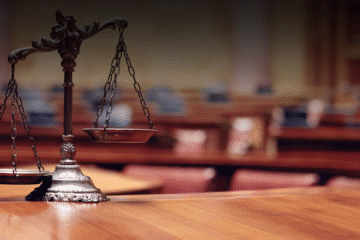
This article is written by Aryya Sinha of Xavier Law School, St. Xavier’s University, Kolkata
ABSTRACT
The Indian legal system has long established a rehabilitative response to juvenile crimes. However, with the passing of the Juvenile Justice (Care and Protection of Children) Act 2015, a shift was made towards a more punitive approach for effectively curbing juvenile crimes. The 2015 Act allowed for children between the ages of 16 to 18 years to be tried as adults, albeit only in cases of heinous crimes. This issue brief discusses the motivations of the Indian political and legal systems behind affecting such a shift and the merit, if any, of moving away from a reformative approach when dealing with children in conflict with the law.
KEYWORDS – Juvenile Justice System, Juvenile Detention Centre, juvenile courts
INTRODUCTION[1]
The juvenile justice system refers to the legal framework and set of institutions responsible for handling cases involving minors who have committed offenses or engaged in delinquent behavior. It operates parallel to the criminal justice system but focuses on the unique needs and circumstances of young individuals who have not yet reached the age of majority.
Key Features of the Juvenile Justice System:
- Age Limit: The juvenile justice system typically applies to individuals below a certain age, usually 18. The exact age of jurisdiction may vary across different jurisdictions.
- Rehabilitation Focus: Unlike the punitive approach of the adult criminal justice system, the juvenile justice system emphasizes rehabilitation and reintegration into society. The primary goal is to address the underlying causes of delinquency and promote positive behavioral changes.
- Confidentiality: Juvenile court proceedings are often confidential, and the records of juvenile offenders are sealed or expunged once they reach adulthood. This approach aims to protect young offenders’ privacy and future prospects, allowing them a chance to overcome their mistakes.
- Diversion Programs: Juvenile justice systems may offer diversion programs as an alternative to formal court proceedings. These programs aim to divert young offenders from the traditional legal process and provide them with community-based interventions, counseling, or education opportunities.
- Juvenile Courts: Juvenile courts handle cases involving minors, and the proceedings differ from those in adult criminal courts. Juvenile courts focus on individualized assessments of the young person’s needs and circumstances when determining appropriate sanctions or treatment.
- Dispositions, not Convictions: Instead of convictions, juvenile courts issue personalities or orders that aim to address the best interests of the minor and the community. Spirits can include counseling, probation, community service, restitution, or placement in residential treatment facilities.
- Juvenile Detention Centers: Juvenile offenders who require secure confinement may be placed in juvenile detention centers. These facilities are designed to provide a more rehabilitative environment than adult prisons and may offer educational programs, vocational training, and counseling services.
- Transfer to Adult Court: In certain circumstances, a juvenile offender may be transferred to the adult criminal justice system. This transfer, or waiver or certification, typically occurs for severe offenses or repeat offenders who require more stringent punishment.
It’s important to note that the specific details and practices of the juvenile justice system can vary between countries, states, and even within different jurisdictions. The aim is to balance accountability and rehabilitation, recognizing the developmental differences and potential for reform among young offenders.
HISTORY OF THE JUVENILE JUSTICE SYSTEM IN INDIA[2]
The history of the juvenile justice system in India can be traced back to the colonial era and has undergone significant changes over time. Here is an overview of the key milestones and developments:
- Early Influences (19th Century): During British colonial rule, separate justice for juveniles emerged. The British authorities recognized the need for a different approach to dealing with young offenders based on age and immaturity.
- Reformatory Schools Act (1854): The Reformatory Schools Act was the first legislation in India that focused on the rehabilitation and reformation of juvenile offenders. It established reformatories to provide young offenders with education, vocational training, and moral guidance.
- Madras Children’s Act (1920): The Madras Children’s Act was the first comprehensive legislation explicitly dealing with juvenile offenders. It provided for establishing juvenile courts, probation officers, and certified schools. It also emphasized the welfare and protection of children.
- Post-Independence Era (1947 onwards): After India gained independence, several states enacted juvenile justice legislation. However, there needed to be unified national legislation addressing juvenile justice.
- Juvenile Justice Act, 1986: In response to the growing need for a comprehensive and uniform law on juvenile justice, the Juvenile Justice Act was enacted in 1986. This legislation focused on the rehabilitation, care, and protection of children in conflict with the law. It established special juvenile courts, probation officers, and observation homes for young offenders.
- Amendment of the Juvenile Justice Act (2000): In 2000, the Juvenile Justice Act was amended to align it with the United Nations Convention on the Rights of the Child (UNCRC). The amendment introduced provisions for diversion, counseling, and other alternatives to custodial sentences.
- Juvenile Justice (Care and Protection of Children) Act, 2015: Recognizing the need for a more child-centric approach, the Juvenile Justice Act was further amended and replaced by the Juvenile Justice (Care and Protection of Children) Act in 2015. This act incorporated provisions to strengthen the child protection system, promote rehabilitation, and protect children’s rights in conflict with the law.
The current Juvenile Justice (Care and Protection of Children) Act, 2015 emphasizes the principle of the child’s best interests. It aims to ensure juvenile offenders’ care, protection, and rehabilitation. It includes provisions for social reintegration, foster care, adoption, and establishing child welfare committees and young justice boards at the district and state levels.
It’s important to note that the information provided represents a general overview of the history of the juvenile justice system in India, and specific details and provisions may vary over time and across different states within the country.
Some key changes introduced by the 2015 act include:
- Recognizing the age group of 16 to 18 years as a separate category, with different provisions for their treatment and rehabilitation.
- Establishing Juvenile Justice Boards (JJBs) in each district to handle cases of juveniles in conflict with the law.
- Establishing Child Welfare Committees (CWCs) at the district level to address cases of children in need of care and protection.
- Emphasizing alternative measures to institutionalization, such as counseling, community service, and foster care.
- Protecting the rights of juveniles, including privacy, dignity, and the right to be heard.
- Strengthening mechanisms for the monitoring and inspection of childcare institutions.
It is important to note that legislation is subject to change, and there may have been further amendments or revisions to the Juvenile Justice Act since my knowledge cutoff in September 2021.
ROLE OF JJ ACT IN PROTECTING JUVENILES IN INDIA[3]
The Juvenile Justice (Care and Protection of Children) Act protects Indian juveniles in several ways. Here are some critical aspects of the act that contribute to the protection and well-being of juveniles:
- Age-based Protection: The act defines a juvenile as someone who has not attained the age of 18. By recognizing this age threshold, the act ensures that juveniles receive special legal protection and are treated differently from adult offenders.
- Rehabilitation and Reintegration: The act emphasizes the rehabilitation and reintegration of juvenile offenders into society. It promotes their education, vocational training, and skill development to enable them to lead productive lives. The focus is on addressing the underlying causes of their behavior and providing opportunities for positive change.
- Diversion and Alternatives to Custody: The act encourages diversion programs and alternatives to custody for juvenile offenders. It recognizes that many young offenders can be effectively rehabilitated through counseling, community service, restitution, or other appropriate measures without imprisonment.
- Juvenile Justice Boards (JJBs): The act establishes Juvenile Justice Boards at the district level, composed of magistrates and social workers. JJBs are responsible for conducting inquiries and determining appropriate actions for juveniles in conflict with the law. They ensure that the proceedings are child-friendly and that the child’s best interests are considered.
- Child Welfare Committees (CWCs): The act also establishes Child Welfare Committees at the district level to deal with children needing care and protection. CWCs ensure the welfare and protection of vulnerable children, including abandoned, orphaned, or abused juveniles.
- Protection of Rights: The act ensures that the rights of juveniles are protected throughout the legal process. It guarantees the right to legal representation, confidentiality, privacy, and a child-friendly atmosphere during hearings. It also prohibits the use of corporal punishment or any form of cruel or degrading treatment.
- Specialized Institutions: The act provides for establishing observation homes, special homes, and places of safety to house and care for juveniles in conflict with the law or in need of care and protection. These institutions are intended to provide a safe and supportive environment for juveniles. At the same time, their cases are being heard during their rehabilitation.
- Sensitization and Training: The act emphasizes the need for sensitizing and training all stakeholders involved in the juvenile justice system, including police officers, judges, lawyers, probation officers, and social workers. This ensures that they have a proper understanding of juvenile issues and can effectively handle cases involving juveniles.
By incorporating these provisions, the Juvenile Justice Act aims to safeguard the rights and well-being of Indian juveniles, promoting their rehabilitation and reintegration into society while recognizing their vulnerabilities and potential for positive change.
Juvenile Justice Board
The Juvenile Justice Board (JJB) is a critical institution within the Juvenile Justice (Care and Protection of Children) Act framework. It is an integral part of the juvenile justice system, specifically designed to protect the rights and interests of juveniles in conflict with the law.
The JJB consists of a magistrate and social workers who specialize in child rights and welfare. Its primary function is to ensure a fair and child-friendly legal process for juvenile offenders. The board conducts inquiries, hearings, and deliberations to determine appropriate actions and decisions for each individual case.
The JJB operates based on justice, rehabilitation, and reintegration principles. It takes into consideration the age, maturity, and circumstances of the juvenile, as well as the gravity of the offense committed. The board aims to balance the need for accountability with the objective of promoting the rehabilitation and reintegration of the juvenile into society.
During the proceedings, the JJB ensures that the rights of the juvenile are upheld, including the right to legal representation, confidentiality, and protection against any form of mistreatment or discrimination. It creates a child-friendly atmosphere where the juvenile feels comfortable expressing their views and concerns.
The decisions made by the Juvenile Justice Board can include various measures such as counseling, probation, community service, vocational training, or placement in a special home or institution. Incarceration or detention is considered a last resort and for a limited period, focusing on the rehabilitation and reformation of the juvenile.
Overall, the Juvenile Justice Board plays a crucial role in safeguarding the rights of juveniles in conflict with the law and ensuring that their rehabilitation and reintegration remain central to the juvenile justice system.
Child Welfare Committee
Child Welfare Committees (CWCs) are essential institutions established under the Juvenile Justice (Care and Protection of Children) Act. They play a crucial role in ensuring the welfare and protection of children needing care and protection.
CWCs comprise a chairperson and four members, including at least one woman. These committees operate at the district level and address cases involving children who are abandoned, orphaned, neglected, or victims of abuse, exploitation, or trafficking.
The primary function of CWCs is to provide immediate and long-term care and protection for children in need. They receive reports and complaints concerning child welfare issues, conduct inquiries, and make decisions based on the child’s best interests.
CWCs have the authority to take various measures to protect and rehabilitate children. They can issue orders for sheltering the child in a children’s home, placing the child under foster care, or arranging for the child’s adoption, if necessary. CWCs also oversee institutions providing care to children and monitor their adherence to prescribed standards.
In addition to addressing individual cases, CWCs have a broader role in promoting child welfare. They collaborate with other stakeholders, including child protection agencies, NGOs, and government bodies, to develop policies, programs, and initiatives to improve children’s overall well-being in their respective districts.
CWCs play a crucial role in safeguarding the rights and ensuring the welfare of vulnerable children. They work to provide a safe and nurturing environment for children in need, advocating for their best interests and facilitating their rehabilitation and reintegration into a supportive family or society.
CASE LAWS UNDER JJ ACT[4]
Certainly! Here are a few notable case laws related to the juvenile justice system in India:
- Gopalan vs. State of Madras (1950): In this case, the Supreme Court of India upheld the constitutionality of the Juvenile Justice Act 1938. It recognized the need for a separate system for dealing with juvenile offenders and acknowledged the importance of their reformation and rehabilitation.
- Sheela Barse vs. Union of India (1986): This case dealt with the rights and conditions of juveniles in observation homes and protective homes. The Supreme Court emphasized the need for proper facilities, education, and welfare programs for juveniles in these institutions. It highlighted the importance of a child-centric approach and protecting the rights and dignity of juveniles.
- Salil Bali vs. Union of India (2013): This case addressed the issue of the determination of juvenility. The Supreme Court clarified that the age of the accused at the time of the commission of the offense should be considered for determining juvenility rather than the age at the time of the trial. This decision had significant implications for the application of the Juvenile Justice Act.
- Sampurna Behura vs. Union of India (2014): This case dealt with the constitutional validity of the provision in the Juvenile Justice Act that allowed for the transfer of a juvenile to the adult criminal justice system in cases of heinous offenses. The Supreme Court held that the provision was not in violation of the constitutional rights of the juvenile and upheld its validity.
- Jarnail Singh vs. State of Haryana (2013): This case addressed the issue of sentencing in cases involving juveniles. The Supreme Court held that in cases where a juvenile is convicted, the focus should be on reform and rehabilitation rather than retribution. It emphasized the importance of individualized sentencing and taking into account the circumstances and prospects of the juvenile offender.
These are just a few examples of significant case laws related to the juvenile justice system in India. The judicial interpretation of the law continues to evolve, and there may be other notable cases that have emerged since my knowledge cutoff in September 2021.
CONCLUSION
The role and objectives of the juvenile justice system in India are pivotal in ensuring the care, protection, and rehabilitation of children in conflict with the law and children in need of care and protection. It aims to provide a child-centric and child-friendly approach, prioritizing the best interests of the child in all proceedings and decisions. By establishing specialized institutions such as Juvenile Justice Boards, Child Welfare Committees, observation homes, special homes, and children’s homes, the system ensures fair and just treatment, protection of rights, and opportunities for rehabilitation and social reintegration. The juvenile justice system also emphasizes the importance of education, skill development, counseling, and support services to enable the holistic development of children. Ultimately, the objectives of the system are to safeguard the rights and well-being of children, promote their rehabilitation and reintegration into society, and pave the way for their successful transition into responsible adulthood.
[1] 201602.juvenile2015pdf.pdf (indiacode.nic.in)
[2] Juvenile Justice (Care and Protection of Children) Act, 2015 – Wikipedia
[3] Introduction and Overview of the Juvenile Justice Care and Protection Act, 2015 – iPleaders
[4] Landmark Judgments On Juvenile Justice & Protection Of Children (lawyersclubindia.com)




0 Comments